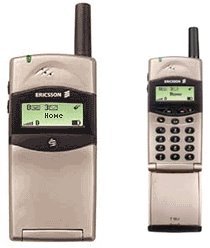TDMA
Time Division Multiple Access (TDMA) is a channel access method allowing multiple devices to be connected to the same multi-point transmission medium and to share its capacity. TDMA is a widely used technology for cellular, satellite and military wireless communications

Ericsson T-18d IS-136 TDMA cellphone with IS-130/IS-135 asychronous data fax capability, a second generation cellular phone.
During the 1990's, second generation cellular networks were primarily TDMA based. Those conforming to the IS-136 standard dominated the North American cellular market while those conforming to the GSM standard dominated the European market.
A main feature of IS-136 TDMA was that phones could operate where AMPS, or TDMA was available. This dual mode capability was important given the large market presence of AMPS at the time.
Other features of IS-136 TDMA were improved battery life, improved voice quality, messaging services, over the air activation and provisioning, intelligent roaming, cell reselection, multiple system support; public, private and residential system, asynchronous data/fax and improved security.
IS-136 TDMA retained the same 30 KHz bandwidth as AMPS and was commonly called digital AMPS or D-AMPS. D-AMPS phones could operate in either the 800 MHz or 1900 MHz bands. IS-136 TDMA used existing 800 MHz AMPS channels for AMPS and new 800 MHz and 1900 MHz channels for D-AMPS.
A phone could transition smoothly between digital and analog systems through cell selection, reselection or handoffs. However, many advanced features of IS-136 TDMA were not backward compatible with those of AMPS.
D-AMPS capacity was increased over the preceding analog design by dividing each 30 KHz channel pair into three time slots and digitally compressing the voice data, thereby resulting in three times the call capacity of a single cell. A digital system also made calls more secure because analog scanners could not access digital signals.
By year 2000, considerable effort was being placed on third generation technologies. CDMA had established itself in North America and parts of Asia while The competing TDMA standard GSM gained worldwide acceptance. In terms of global market share, IS-136 TDMA had the third largest market share.
With the AMPS installed base dwindling and IS-136 TDMA showing little upside global market potential, non-CDMA cellular providers in North America made a decision to migrate away from IS-136 TDMA. Most adopted GSM over CDMA.




